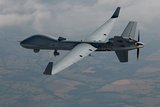SmartNode Pod linked with US Army HARC system in demo
Northrop Grumman has announced that it has successfully completed a series of ground and flight tests in which its SmartNode Pod was linked with the US Army's High Antenna for Radio Communications (HARC) system. The demonstration showed that linking the pod and HARC system can enhance information communication connectivity between ground, air and remote network nodes.
During the tests, carried out at Mojave in July, the SmartNode Pod was mounted on a Firebird optionally piloted aircraft, enabling HARC to connect with other ground radio networks to form a unified network that operated across different radio systems, including currently deployed legacy systems and radios based on new waveforms.
The SmartNode Pod is based on Northrop Grumman's highly successful Battlefield Airborne Communications Node (BACN) technology that exchanges real-time information among disparate military and commercial radios and data link systems, a critical capability for deployed warfighters. It is designed for use on a variety of aircraft and provides critical range extension and gateway capability controlled by the lowest level commanders.
The HARC system has been developed by the US Army Communications-Electronics Research, Development and Engineering Center. It is an innovative approach with six antennas on an aerostat that connect to ground radios via fibre optical link. HARC floats above an area where line-of-sight communications are hindered by mountainous terrain or urban canyons.
Claude Hashem, vice president of network communications systems for Northrop Grumman Information Systems, said of the demonstration: ‘Commanders need a locally controlled airborne network that provides BACN-like information sharing to the tactical edge of the battlespace. The SmartNode Pod provides a powerful 'platform-agnostic' capability without the significant cost of platform integration.’
Northrop Grumman is the prime contractor for the development, fielding and maintenance of the BACN system. Since Northrop Grumman deployed the BACN system in 2008 to overcome communications limitations, it has delivered near 24/7 coverage in theatre.
More from Digital Battlespace
-
![Babcock nears first customer for Nomad AI translation tool]()
Babcock nears first customer for Nomad AI translation tool
Nomad can provide militaries with real-time intelligence, saving critical time on the battlefield.
-
![AUSA 2025: Israel’s Asio Technologies to supply hundreds of improved Taurus tactical systems]()
AUSA 2025: Israel’s Asio Technologies to supply hundreds of improved Taurus tactical systems
Taurus operates alongside the Israel Defense Forces’ Orion system which supports mission management across tens of thousands of manoeuvring forces, from squad leaders to battalion commanders.
-
![AUSA 2025: Kopin pushes micro-LED plans as China moves faster]()
AUSA 2025: Kopin pushes micro-LED plans as China moves faster
The plan for the new displays follows fresh investment in Kopin’s European facilities by Theon and an order for head-up displays in fielded aircraft, with funding from the US Department of Defense.
-
![AUSA 2025: Persistent Systems to complete its largest order by year’s end]()
AUSA 2025: Persistent Systems to complete its largest order by year’s end
Persistent Systems received its largest ever single order for its MPU5 devices and other systems earlier this month and has already delivered the 50 units to the US Army’s 4th Infantry Division.
-
![Aselsan brings in dozens of companies and systems under the Steel Dome umbrella]()
Aselsan brings in dozens of companies and systems under the Steel Dome umbrella
Turkey has joined the family of countries attempting to establish a multilayered air defence system with government approval in August 2024 for the effort landed by Aselsan. Dubbed Steel Dome, the programme joins Israel’s Iron Dome, the US Golden Dome, India’s Mission Sudarshan Chakra and South Korea’s low-altitude missile defence system.
-
![DSEI 2025: MARSS unveils new agnostic multidomain C4 system]()
DSEI 2025: MARSS unveils new agnostic multidomain C4 system
MARSS’ NiDAR system has been deployed using sensors from static platforms to provide detection and protection for static sights, such as critical infrastructure, ports and military bases.




























